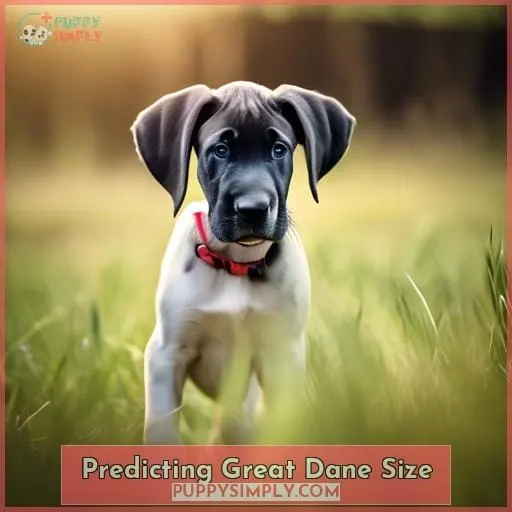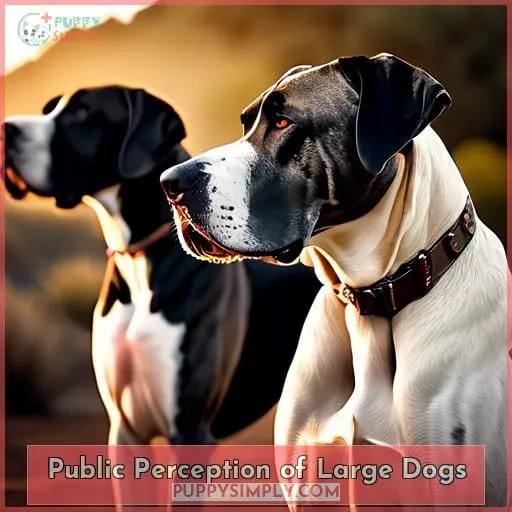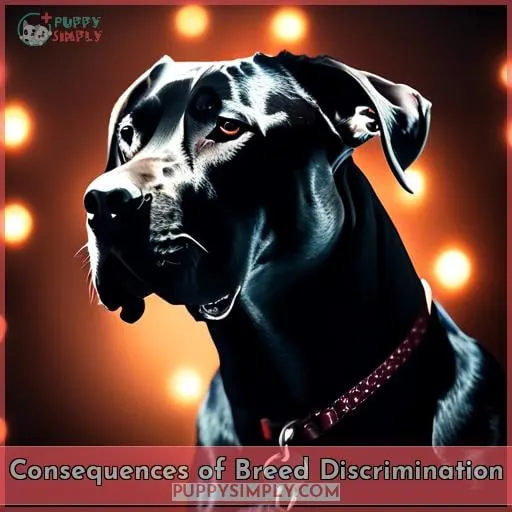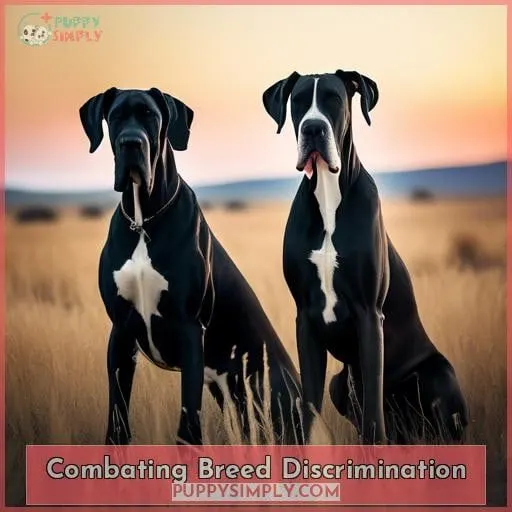This site is supported by our readers. We may earn a commission, at no cost to you, if you purchase through links.
 Majestic and massive, Great Danes epitomize canine grandeur, yet their rapid growth and mix breed variations present unique challenges.
Majestic and massive, Great Danes epitomize canine grandeur, yet their rapid growth and mix breed variations present unique challenges.
You’re about to delve into the world of these gentle giants, exploring how their size can be influenced by genetics and care.
From towering purebreds to diverse mix breed dimensions, we’ll uncover the factors shaping their stature and the health insights crucial for their well-being.
If you’re captivated by the idea of sharing your life with a Great Dane or its mixed counterpart, this guide will arm you with the knowledge to nurture their growth and address the health risks looming over these noble breeds.
Yes, Great Danes can grow very large, with males reaching up to 32 inches tall and weighing between 100 to 200 pounds, while females are slightly smaller. Mix breeds involving Great Danes, such as the Corgi Great Dane mix or the Poodle Great Dane mix, can vary significantly in size depending on the other breed involved, but often inherit the Great Dane’s large stature to some degree.
Table Of Contents
- Key Takeaways
- Great Dane Growth Stages
- Full Maturity of Great Danes
- Size Factors for Great Danes
- Predicting Great Dane Size
- Health Risks for Great Danes
- Breed Discrimination Challenges
- Public Perception of Large Dogs
- Consequences of Breed Discrimination
- Combating Breed Discrimination
- Great Dane Mix Varieties
- Frequently Asked Questions (FAQs)
- How does the climate or environment affect the growth and health of Great Danes and their mixes?
- What are the specific dietary needs of Great Dane mixes compared to purebred Great Danes, especially during their rapid growth phases?
- How do Great Danes and their mixes interact with other pets, especially smaller ones, given their large size and imposing presence?
- Are there any unique grooming or care requirements for Great Dane mixes, particularly those with unusual coat types or colors?
- What role does early socialization play in the temperament and behavior of Great Dane mixes, and how can owners ensure it’s done effectively?
- Conclusion
Key Takeaways
- Great Danes can reach up to 32 inches tall and weigh between 100-200 pounds for males, with females being slightly smaller.
- Mixed breed Great Danes vary in size depending on the other breed involved and inherit traits from both parent breeds.
- Rapid growth occurs in the first 5 months, with full growth typically reached between 18-24 months.
- Choosing large-breed growth dog food can support a slower growth rate and help manage health risks associated with Great Danes.
Great Dane Growth Stages
Understanding the growth stages of Great Danes is crucial for any owner of this majestic breed.
From 1 to 5 months, these puppies undergo rapid growth, with significant increases in both weight and height.
Knowing when they reach full growth, typically between 18 and 24 months, helps in providing the right care and nutrition to support their development.
1. 5 Month Weight and Height
In the first five months, your Great Dane puppy will experience a whirlwind of growth. You’ll notice a significant weight gain and height increase, a testament to their rapid development.
It’s crucial to monitor their growth rate closely, ensuring their weight gain aligns with breed standards. Proper feeding plays a pivotal role in this stage, supporting their Great Dane growth without overburdening their developing joints.
For Great Dane mixes, these guidelines still apply, though their final size may vary. Always consult with your vet to tailor feeding to your Great Dane puppy’s specific needs, promoting healthy growth and development.
Full Growth Timeline
Understanding the full growth timeline of your Great Dane is crucial for ensuring they develop healthily and happily.
- Great Danes experience rapid growth, reaching near full height by 18 months, but they continue to fill out in muscle until about 24 months.
- Gender significantly impacts size, with males generally larger in both weight and height compared to females.
- Observing paw size can offer clues; oversized paws in younger dogs suggest they’ve more growing to do.
This growth journey underscores the importance of tailored nutrition and care to support your Great Dane’s health and well-being throughout their development stages.
Full Maturity of Great Danes
As your Great Dane approaches 18 months, you’ll notice they’ve reached their full height, but they’re not done growing just yet.
They’ll continue to fill out, adding muscle to their large frame well into their second year.
It’s crucial to understand that males typically grow larger and more muscular than females, reflecting the breed’s standards for size and appearance.
Height by 18 Months
By 18 months, your Great Dane’s growth patterns have largely shaped their height, with most reaching their full stature.
Muscle development continues, contributing to weight variation. Breed variation and genetic diversity can influence size, but typically, males weigh at least 120 lbs and females 100 lbs.
Mixed breed Great Danes may show different growth rates and final sizes due to their mixed heritage.
Muscle Development
After reaching their full height, Great Danes continue to develop in muscle mass, density, and tone. This phase is crucial for achieving their majestic appearance and strength. Proper nutrition, regular training, and understanding their behavior are key to supporting healthy muscle development and avoiding health issues.
- Nutrition: High-quality food that supports muscle growth without accelerating it too quickly.
- Training: Regular, gentle exercises that promote muscle building and tone without overstraining.
- Behavior: Understanding the link between behavior and physical health can guide appropriate exercise.
- Health Issues: Being vigilant about signs of joint issues or hip dysplasia, which can be exacerbated by improper muscle development.
Size Factors for Great Danes
When considering the size of Great Danes, it’s crucial to note the significant role gender plays in their growth.
Males typically outsize females, showcasing a more massive frame and heavier bone structure. This difference isn’t just in weight but extends to overall stature, reflecting a fascinating aspect of their genetic makeup.
Gender Differences
Continuing from the discussion on the full maturity of Great Danes, it’s important to note the gender differences that affect their size variation.
Males typically outsize females, with a more massive frame and heavier bone structure. This size variation is crucial when considering health concerns, as larger dogs may have different needs.
For Great Dane mixes, these gender differences can influence mix breed traits, potentially affecting growth comparison and the need for Great Dane insurance.
Growth Comparison to Humans
Continuing from the gender differences in Great Danes, it’s fascinating to consider their early growth stages in comparison to humans.
- Great Danes can grow as much in one year as a human does in fourteen years.
- Paw size can be a telltale sign of a puppy’s future stature, hinting at more growth.
- Estimating a Great Dane mix’s size requires understanding their unique, rapid growth patterns.
- The best dog food for a Great Dane mix supports their swift development while managing health risks.
Predicting Great Dane Size
If you’re curious about how large your Great Dane might get, there are a few indicators to consider.
You can consult the breeder for insights on the expected size based on the puppy’s lineage and past litters.
Additionally, the size of your Great Dane’s paws compared to their legs and body can be a telltale sign of future growth, as oversized paws often mean they have more growing to do.
Under Two Years Growth
Understanding your Great Dane’s growth in the first two years is crucial. During this period, they’re not just gaining weight but also building muscle mass, which is essential for their overall size and health.
The growth rate of these gentle giants is astonishing, with significant weight gain and size increase. Predicting their final size involves considering breed standards and observing their current growth trends.
It’s also vital to manage their diet to prevent health issues like hip dysplasia or GDV. For Great Dane mixes, food requirements may vary, so it’s important to tailor their nutrition to support healthy growth and prevent conditions like degenerative lumbosacral stenosis.
Breeder Insights
Continuing from understanding the growth patterns of Great Danes under two years, breeder insights become invaluable for predicting your pup’s full size.
Breeders, with their deep knowledge of genetics and breed standards, can provide a more accurate full growth timeline. They consider gender differences, potential genetic conditions, and the specific lineage of your Great Dane or mix breed.
This expertise not only helps in anticipating growth but also in preparing for any health insights that might affect your dog’s development.
Engaging with a breeder offers a unique perspective on what to expect, ensuring you’re well-informed about your Great Dane’s journey to reaching their majestic size.
Paw Size Indicators
When estimating your Great Dane’s future size, paw size can be a telling indicator. Large paws on a puppy suggest they have more growing to do, as they will need to fill out their frame and develop muscle.
This growth prediction tool helps gauge how much more your gentle giant may expand before reaching their full, majestic stature.
Keep in mind, mixed breeds may vary, but health insights generally apply across the board.
Health Risks for Great Danes
As a Great Dane owner, you should be aware of the breed’s susceptibility to certain genetic health issues.
Your dog’s diet plays a crucial role in managing their growth and minimizing the risk of conditions like hip dysplasia.
It’s important to choose a large-breed growth dog food that supports a slower growth rate to help protect their joints.
Genetic Conditions
As a Great Dane owner, you’re likely aware of the breed’s susceptibility to certain genetic conditions.
Hip dysplasia and bloat are two significant health concerns. Hip dysplasia can cause joint issues, while bloat is a potentially life-threatening stomach condition.
Hypothyroidism can also affect your Dane’s metabolism. Additionally, wobbler syndrome, dilated cardiomyopathy, and happy tail syndrome are other risks to be mindful of.
It’s crucial to monitor for signs of these conditions to ensure your pet’s well-being.
Diet for Growth Control
To manage your Great Dane’s growth effectively, focus on their diet.
A well-balanced diet slows growth, preventing stress on joints and reducing the risk of hip dysplasia and bloat.
Opt for high-quality food designed for large breeds, emphasizing controlled growth and health maintenance.
This approach is crucial for your Dane’s long-term well-being, ensuring they grow strong without undue strain on their developing body.
Breed Discrimination Challenges
Misconceptions and stereotypes about Great Danes can lead to breed-specific legislation that unfairly targets these gentle giants.
Despite their imposing size, Great Danes are known for their friendly and affectionate nature.
However, breed discrimination can result in these dogs facing unwarranted scrutiny and can contribute to the spread of false information about their temperament.
Misconceptions and Stereotypes
Misconceptions and stereotypes about Great Danes and their mix breeds can distort perceptions, leading to unfair judgments.
You might think their large size equates to aggression, but these gentle giants often defy such stereotypes with their friendly demeanor.
Understanding their growth patterns and health needs is crucial, as is recognizing that each dog’s temperament is unique, regardless of breed.
Don’t let misconceptions cloud your view of these majestic dogs.
Breed-Specific Legislation
Breed-specific legislation often targets large breeds like Great Danes, influenced by stereotypes and misconceptions.
- Understand that legislation may be based on unfounded fears, not factual behavior.
- Recognize that Great Danes and mix breeds suffer from such bias, affecting their care.
- Promote education on Great Dane joint problems and the importance of preventive care.
- Advocate for responsible Great Dane veterinary care, rather than restrictive laws.
Public Perception of Large Dogs
Public perception of large dogs like Great Danes often varies widely.
You might encounter someone who compares your Great Dane to a horse and expresses a desire to ride them, while others may react with fear or ignorance, questioning if such a large dog is safe.
Apollo, a Great Dane known for his love of ear rubs, food, and sitting on laps, demonstrates that despite their size, these dogs can be gentle, well-trained companions.
Varied Human Reactions
Continuing from the challenges of breed discrimination, it’s important to recognize the varied human reactions to large dogs like Great Danes. Your dog preferences and social interactions can be influenced by safety concerns, training difficulties, and legal implications.
For instance, a Poodle Great Dane mix or a Labrador Great Dane mix may be perceived differently than a Pitbull Great Dane mix or a Rottweiler Great Dane mix due to stereotypes associated with these breeds.
Here’s a table summarizing common reactions to large breed dogs:
| Reaction Type | Description | Example Breeds |
|---|---|---|
| Horse Connoisseur | Compares dog to horse, may joke about riding the dog. | Golden Retriever Great Dane mix |
| Scared Human | May walk away or scream upon seeing a large dog. | Rottweiler Great Dane mix |
| Ignorant | Asks if the dog will bite, comments on size without understanding behavior. | Pitbull Great Dane mix |
| Dog Lover | Enjoys the gentle nature of large dogs, regardless of breed. | Poodle Great Dane mix |
Understanding these reactions can help mitigate negative stereotypes and promote a more informed and compassionate view of large breed dogs.
Apollo’s Traits
Continuing from the varied reactions people have towards large breeds like Great Danes, let’s delve into the specific traits of one such dog, Apollo.
- Apollo’s favorite things: He loves ear rubs, indulging in his meals, and despite his size, enjoys sitting on laps, showing his affectionate nature.
- Apollo’s training: Apollo is well-trained, knowing 12 commands and tricks, which is a testament to the breed’s intelligence and capability for obedience.
- Apollo’s traits: His calm demeanor and excellent leash manners make him a joy to walk, challenging misconceptions about Great Danes and providing insights into their growth and health.
Consequences of Breed Discrimination
Breed discrimination can lead to a spread of misinformation and negative stereotypes about dogs like Great Danes. This not only affects the perception of these breeds but also has real consequences for the dogs and their owners.
It’s crucial to understand that such biases can result in unfair treatment and legislation, impacting the well-being of these gentle giants.
Spread of False Information
As you’ve seen, Great Danes and their mix breeds often face breed-specific laws due to media portrayal and public perception. These breed stereotypes can lead to fear and aggression, impacting both the dogs and their owners.
It’s crucial to understand that breed-specific legislation often stems from misinformation and doesn’t consider individual dog behavior or responsible ownership. Your Great Dane’s growth and health are more than just sizes; they’re about combating these misconceptions with facts and positive experiences.
Impact on Dogs and Owners
Breed discrimination not only spreads myths and stereotypes but also significantly impacts both Great Danes and their owners.
- Increased legislation: Breed-specific laws can restrict ownership, leading to fewer homes for giant breeds.
- Stress on pet health: Discrimination can cause stress, affecting the pet’s overall well-being.
- Challenges for pet parents: Owners often face hurdles in housing and social acceptance.
- Perpetuation of myths: Stereotypes about size and aggression continue, despite evidence to the contrary.
- Limited access to resources: Discrimination may restrict access to parks, services, and community spaces.
Understanding the true nature of Great Danes, including how big they get and the unique qualities of mixes like the Great Pyrenees Great Dane mix or the Bernese Mountain Dog Great Dane mix, is essential for combating these issues.
Combating Breed Discrimination
To combat breed discrimination, it’s crucial to educate yourself and others about dog behavior and the specific needs and characteristics of different breeds, including Great Danes.
Volunteering at local shelters can offer firsthand experience with a variety of dogs, helping to dispel myths and stereotypes.
Understanding that a dog’s behavior is more influenced by training, socialization, and individual personality than by breed alone can lead to more informed and compassionate interactions with all dogs.
Educating on Dog Behavior
Continuing from the discussion on the detrimental effects of breed discrimination, it’s crucial to focus on educating the public about dog behavior. Understanding dog body language is key to ensuring dog safety and preventing misconceptions about dog aggression.
For instance, a corgi Great Dane mix or a dachshund Great Dane mix may inherit a unique blend of traits affecting their behavior and communication. It’s not just about size; a pug Great Dane mix or a cocker spaniel Great Dane mix may also display a range of behaviors that require interpretation.
Dog training can help mitigate issues, but it’s also about public awareness. Recognizing signs of discomfort or stress in dogs, such as a French bulldog Great Dane mix, can prevent negative encounters and promote harmonious interactions between dogs and humans.
Volunteering at Shelters
Volunteering at shelters offers a unique opportunity to combat breed discrimination while enriching both your life and the lives of animals.
- Direct Impact: You’ll provide essential care and love, improving the welfare of animals directly.
- Awareness: Gain firsthand experience with breeds like the beagle Great Dane mix or the chihuahua Great Dane mix, challenging stereotypes.
- Community Outreach: Engage in community outreach, educating others about the gentle nature of large breeds, including the boxer and bull mastiff Great Dane mixes.
- Responsibility: Learn about the responsibility of pet ownership, especially for unique mixes like the German shepherd Great Dane mix, fostering a deeper understanding and respect for all breeds.
Great Dane Mix Varieties
Great Danes are known for their impressive size and gentle temperament, making them a popular choice for crossbreeding with other dog breeds.
These mix breeds often inherit the large size and friendly nature of the Great Dane, resulting in a variety of unique and lovable dogs.
Understanding the potential size and temperament of Great Dane mixes is crucial for prospective owners to ensure they can provide the appropriate care and environment for these large companions.
Common Mix Breeds
Exploring the world of Great Dane mix breeds reveals a fascinating blend of traits, temperament, health considerations, and popularity. These mixes often inherit the gentle nature of the Great Dane while showcasing unique characteristics from their other breed parent.
| Mix Breed | Traits | Popularity |
|---|---|---|
| Newfoundland Great Dane Mix | Gentle giants, excellent swimmers | High |
| Husky Great Dane Mix | Energetic, striking eyes | Moderate |
| Chow Chow Great Dane Mix | Loyal, distinctive mane | Low |
| Border Collie Great Dane Mix | Intelligent, highly trainable | Moderate |
| Australian Shepherd Great Dane Mix | Energetic, great herders | High |
Each mix brings something special to the table, from the Newfoundland mix’s affinity for water to the Australian Shepherd mix’s herding prowess. When considering a Great Dane mix, it’s essential to research mix breed health, temperament, and availability to ensure they fit well into your lifestyle.
Mix Breed Size and Temperament
Continuing from the discussion on common Great Dane mix breeds, let’s delve into the size and temperament of these majestic hybrids:
- Mix Breed Health: Great Dane mixes may inherit health issues from both parent breeds, such as hip dysplasia and heart conditions. Regular vet check-ups are crucial.
- Mix Breed Temperament: These gentle giants often display a friendly and affectionate nature, making them excellent family pets.
- Mix Breed Lifespan: While large breeds typically have shorter lifespans, a mix may benefit from hybrid vigor, potentially leading to a longer life.
- Mix Breed Activity Level: They require regular exercise to maintain their health and happiness, so be prepared for daily walks and playtime.
Whether you’re considering a Bernard Great Dane mix, an American Bulldog Great Dane mix, a Cane Corso Great Dane mix, an Akita Great Dane mix, or an English Bulldog Great Dane mix, you’ll find that these dogs aren’t only impressive in size but also in their capacity for love and loyalty.
Mix breed intelligence varies, but these dogs are often quick learners and respond well to positive reinforcement training. Remember, each dog is unique, and their mix breed activity level and other traits will be influenced by their genetics and upbringing.
Frequently Asked Questions (FAQs)
How does the climate or environment affect the growth and health of Great Danes and their mixes?
Climate and environment significantly impact Great Danes and their mixes. This impact can affect their growth, coat health, and susceptibility to certain conditions. Proper care and adjustments are crucial for their well-being in different settings.
What are the specific dietary needs of Great Dane mixes compared to purebred Great Danes, especially during their rapid growth phases?
Great Dane mixes should eat high-quality, large-breed specific food with balanced nutrients to support their rapid growth. Especially in the first year, this is crucial to mitigate joint issues and maintain overall health.
How do Great Danes and their mixes interact with other pets, especially smaller ones, given their large size and imposing presence?
Great Danes and their mixes often exhibit gentle behavior around smaller pets. However, due to their large stature and playful nature, supervision is crucial to ensure safe interactions.
Are there any unique grooming or care requirements for Great Dane mixes, particularly those with unusual coat types or colors?
Ye olde Great Dane mixes may sport coats that range from the standard to the truly unique, requiring bespoke grooming routines.
For those with rare or dilute colors, extra care is needed to maintain their majestic appearance, as these coats can be more prone to skin issues.
Regular baths, brushing, and specific attention to their nails and ears will keep your gentle giant in tip-top shape.
What role does early socialization play in the temperament and behavior of Great Dane mixes, and how can owners ensure it’s done effectively?
Early socialization is crucial for Great Dane mixes, shaping their temperament and behavior.
To ensure it’s effective, introduce them to various people, animals, and environments early on, fostering a well-adjusted, friendly companion.
Conclusion
Soaring beyond the ordinary, Great Danes are the titans of the canine world, with their mix breed cousins boasting a kaleidoscope of sizes.
You’ve learned that these gentle giants reach towering heights and weights, with males typically growing up to 32 inches and tipping the scales between 100 to 200 pounds.
Mix breeds, like the regal Great Poodane or the robust Great Labradane, inherit varied dimensions from their diverse lineage.
Embrace the grandeur of these noble breeds, and you’ll be rewarded with a companion whose size is matched only by their heart.
















